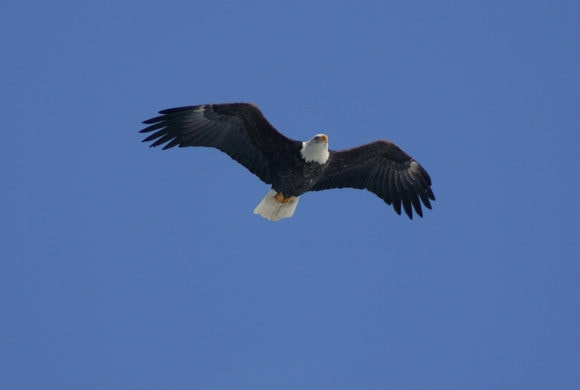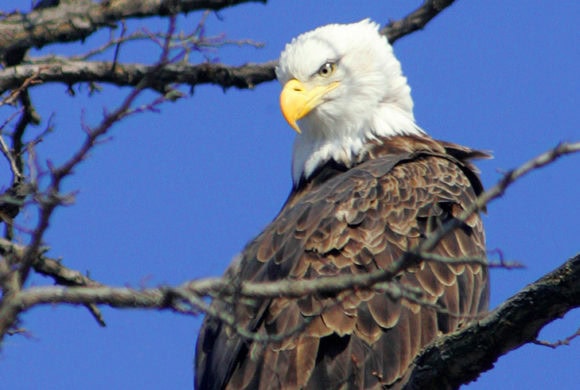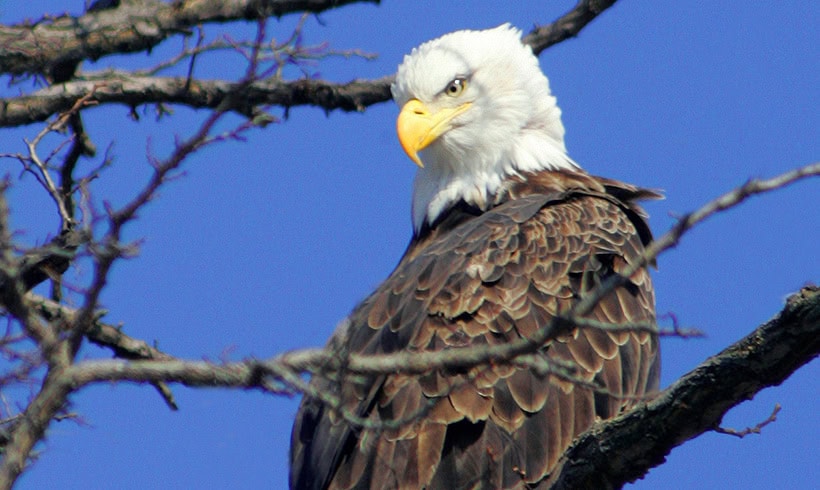Hudson Valley Eagles
Looking up into a bright blue sky on a January day brings tears to my eyes; the brightness stings just as much as the cold does. I scan the sky and surrounding area with my binoculars over the confluence of the Hudson and the Croton Rivers. It is low tide, and many waterfowl are gathered in Croton Bay to rest and search for food. Out of the corner of my eye, I see a large bird’s silhouette as it flies towards me from Croton Point Park, heading for the mouth of the Croton River.

As it nears, I can see the iconic white head and tail as it soars into view. Its wings are long and stretch out perfectly flat, allowing it to ride the wind with little effort of flapping wings. The adult bald eagle circles once around the bay, then perches in a tall tree across the water from where I stand.
Viewing this majestic creature, whether for the first or 101st time, is always breathtaking. Not only are they beautiful, but their conservation story is quite incredible. Bald eagle populations in the lower US declined steadily after the early 1900’s due to habitat loss, logging, hunting and later chemical pollution (DDT). By the mid-1960’s, populations became so low that bald eagles were added to both the Federal and New York’s Endangered Species Lists.
In 1965, only one breeding pair remained in New York State. Unfortunately, this pair was unsuccessful at hatching and raising young. The accumulation of DDT in their bodies weakened the eggs so significantly that they could not withstand the weight of the eagle incubating them. In 1976, the New York State Department of Environmental Conservation (NYSDEC) began a two-phase program to increase bald eagle populations in the state.

The first phase, a fostering program, placed young eaglets from other states into the nest of this remaining New York breeding pair, which successfully raised several broods. The second phase was a hacking program in which young were hand-reared to independence. Young bald eagles were raised in tall platform nests by eagle puppet parents, without direct contact by humans, so the young did not imprint on them. Once the young got to be a certain age, they fledged or flew out of the nesting platform and began hunting on their own. The Bald Eagle Reintroduction program lasted 13 years ending in 1989 when 10 breeding pairs were established. Just a few years ago in the summer of 2017, a NYSDEC survey counted 323 breeding pairs. This marks a tremendous victory not only for wildlife, but also for the people who support and work hard to protect wildlife and the habitats they live in.
As the northern reaches of the Hudson and upstate reservoirs freeze, eagles congregate in the lower Hudson Valley to hunt for food. Winter is a great time of year to walk along the Hudson River and catch a glimpse of a bald eagle on the wing. As you search for eagles, be sure to wear extra layers, bring a hot drink, a pair of binoculars. Be mindful to practice good eagle etiquette while viewing. It may be cold out, but the eagles don’t mind!

About the Author
Maggie Pichura
Senior Environmental Educator
Maggie is a graduate of SUNY Environmental Science and Forestry (ESF) and has been teaching environmental education for 20 years. Although she loves all aspects of nature, her personal passions are birds and native wildflowers. Participating in trail marathons allows her lots of time on trails to train and look for these gems!



Leave a Reply